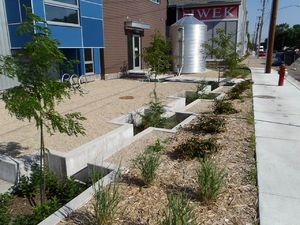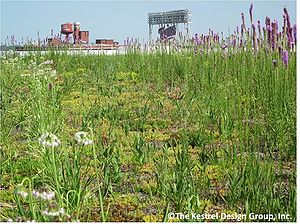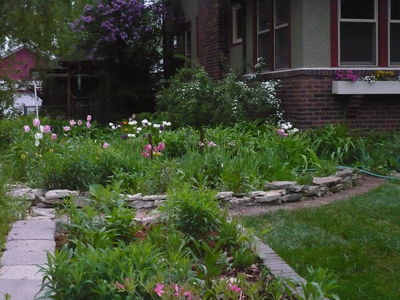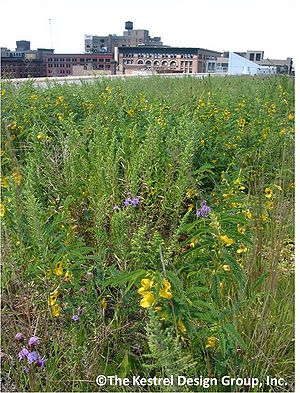
Multiple benefits of green infrastructure and role of green infrastructure in sustainability and ecosystem services
Human activities can negatively impact hydrologic and chemical cycles, pollute air and water, degrade soil, and reduce biodiversity. Failure to maintain basic ecosystem functions places humans at risk because of our dependence on these functions. As human populations and resource consumption increase, it becomes even more important to preserve basic ecosystem functions. Sustainability is the principle and practice of creating and maintaining the conditions under which humans and nature can exist in productive harmony to support present and future generations. Green infrastructure is one tool or approach to creating sustainable urban environments.
Contents
- 1 What are ecosystem services?
- 2 Sustainability
- 3 Relationship of green infrastructure to ecosystem services and sustainability
- 4 Environmental benefits of green infrastructure
- 5 Other benefits of green infrastructure
- 6 Recommended reading
- 7 References
What are ecosystem services?
The natural environment provides basic services required for humans and all life to survive. These ecosystem services can be divided into four basic categories or types ([1], [2], [3]).
- Supporting services are basic services needed to support all other ecosystem services. An example is primary production, which is the production of organic compounds from carbon dioxide. Plants and algae are largely responsible for primary production. Other examples of supporting services are nutrient cycling and soil formation. These services provide basic materials needed by organisms.
- Provisioning services are products obtained from ecosystems, such as food, minerals, lumber, energy, medicines, and water. It is these services that humans typically rely on for economic purposes and to improve quality of life. The concern is that in utilizing provisioning services we degrade other services.
- Regulating services ensure the continued availability of other ecosystem services. Examples include purification of air and water, waste composition, and climate regulation. Humans often stress these systems. For example, introducing too much phosphorus into a lake impairs the ability of the lake to regulate the growth of algae.
- Cultural services are unique to humans. Though not essential to survival, they are important for human well-being and development. Examples include the use of ecosystems for recreation, scientific development, and education.
Numerous studies attempt to place a dollar value on ecosystem services, though the value of these services is infinite in the sense that human survival depends on them. Costanza et al. (2014) place an annual value of 125 to 145 trillion dollars on ecosystem services, which is more than double the global GDP. The authors also estimate an annual loss of 4.3 to 20.2 trillion dollars, underscoring the negative impact humans are having on basic ecosystem functions necessary for our well-being.
Sustainability
A central tenet of sustainability is that we must preserve ecosystem services necessary for humans to survive and prosper. In 1987, a World Commission on Environment and Development report (UN, 1987) defined sustainable development as "development that meets the needs of the present without compromising the ability of future generations to meet their own needs".
A challenge is incorporating basic sustainability concepts into social and economic systems. These systems historically have not placed proper value on ecosystem services, resulting in the degradation of these services. For example, stormwater in urban areas was traditionally viewed as something that negatively impacted humans, primarily through flooding. Traditional stormwater systems were designed to discharge stormwater to the nearest receiving water as quickly as possibly. The result was a dramatic change in urban hydrology, increased flooding downstream, reduced water quality, and loss of habitat. Sustainability stresses using stormwater as a resource. Using stormwater as a resource restores some natural resource function and provides economic and social benefit. Sustainable practices achieve a balance between environmental, social, and economic factors.
Relationship of green infrastructure to ecosystem services and sustainability
Green infrastructure is an approach to managing urban wet weather impacts that mimics, restores, or maintains natural hydrology. Green infrastructure includes a wide array of practices, including infiltrating, evapotranspiring, or harvesting and using stormwater. On a regional scale, green infrastructure is the preservation or restoration of natural landscape features, such as forests, floodplains and wetlands. On the local scale, green infrastructure consists of site and neighborhood-specific practices, such as bioretention, trees, green roofs, permeable pavements and cisterns. Regional and local practices are coupled with policies such as infill and redevelopment that reduce overall imperviousness in a watershed.
Green infrastructure is an important component of sustainable urban communities. Green infrastructure helps maintain ecosystem services in the following ways.
- Air quality regulation: Potential of ecosystems to capture and remove air pollutants in the lower atmosphere.
- Erosion protection: Potential of ecosystems to retain soil and to prevent erosion and landslides.
- Water flow regulation: Influence ecosystems have on the timing and magnitude of water runoff and aquifer recharge, particularly in terms of water storage potential.
- Pollination: Potential of animal vectors (bees being the dominant taxon) to transport pollen between flower parts
- Maintenance of soil structure and quality: The role ecosystems play in sustaining the soil's biological activity, physical structure, composition, diversity and productivity.
- Water purification: The role of biota in biochemical and physicochemical processes involved in the removal of wastes and pollutants from the aquatic environment
- Climate regulation: The influence ecosystems have on global climate by regulating greenhouse and climate active gases (notably carbon dioxide) from the atmosphere.
The following section provides detailed information on each of these. For more information on stormwater green infrastructure practices, link here.
It is beyond the scope of this page to describe in detail the relationship between green infrastructure, sustainability, ecosystem services, and stormwater. Some suggested references on this topic are provided below.
- Mapping green infrastructure based on ecosystem services and ecological networks: A Pan-European case study - the paper presents a methodology that can be used to identify and map GI elements at landscape level based on the notions of ecological connectivity, multi-functionality of ecosystems and maximisation of benefits both for humans and for natural conservation.
- Using the Concepts of Green Infrastructure and Ecosystem Services to Specify Leitbilder for Compact and Green Cities—The Example of the Landscape Plan of Dresden (Germany) - this study applies the concepts of green infrastructure and ecosystem services to develop a guideline for landscape planning to foster compact and green cities. The guideline was tested on the example of the landscape plan of Dresden, Germany.
- Enhancing Sustainable Communities with Green Infrastructure - this EPA documents provides a good discussion of green infrastructure and sustainable communities. The document provides strategies that support sustainable communities and green infrastructure.
- The Multifunctionality of Green Infrastructure - this report describes the different functions that GI seeks to execute and explores the scientific evidence behind its ability to perform these functions, using case studies where available. Stormwater is not a focal point of this report.
- The Value of Green Infrastructure - A Guide to Recognizing Its Economic, Environmental and Social Benefits - this guide distills key considerations involved in assessing the economic merits of green infrastructure practices. There is a chapter devoted to water-related aspects of green infrastructure.
- The Economic Benefits of Green Infrastructure
- Promoting ecosystem and human health in urban areas using Green Infrastructure: A literature review - this paper discusses the possible contributions of urban and peri-urban green space systems, or Green Infrastructure, on both ecosystem and human health
- From Multifunctionality to Multiple Ecosystem Services? A Conceptual Framework for Multifunctionality in Green Infrastructure Planning for Urban Areas - this paper explores how multifunctionality as one important principle of green infrastructure planning can be operationalized by approaches developed and tested in ecosystem services research.
Environmental benefits of green infrastructure
An increasing focus on Green Infrastructure has brought an awareness that stormwater management can provide numerous benefits beyond improving water quality and urban hydrology. Trees, for example, provide a multitude of benefits beyond stormwater management, as discussed in this article. In particular, vegetated stormwater best management practices (BMPs), including tree-based systems and other bioretention systems, offer opportunities to achieve multiple benefits, ranging from aesthetics (see, for example, this presentation by Dr. Steven Rodie from the University of Nebraska - Omaha) to ecosystem friendly designs.
Impact on pollinators
It is clear that pollinators, both vertebrates and invertebrates, are in decline (see [4], [5], [6], [7], [8]). Vegetated stormwater BMPs can be designed to be pollinator-friendly. The following sections provide numerous links to information that can be used in designing and implementing pollinator-friendly stormwater BMPs.
Pollinator friendly plants
- Minnesota Stormwater Manual
- Metro Blooms: Planting for Pollinators: How Raingardens Can Help
- The Xerces Society for Invertebrate Conservation: Pollinator plants - Great Lakes Region
- Pollinator Partnership: Ecoregional Planting Guides
- United States Department of Agriculture - Forest Service: Attracting Pollinators to Your Garden Using Native Plants
- National Wildlife Federation: Plants for Pollinators: A Collection of Favorites
- Deeproot: Want Pollinators? Plant Trees
- Native Seed Mix Design for Roadsides: Minnesota Department of Transportation
Pollinator friendly practices
Although much of the information on these pages is general, many of the practices can be incorporated into vegetated stormwater BMPs.
- United States Department of Agriculture - Forest Service: Pollinator Friendly Practices
- North American Pollinator Protection Campaign: Pollinator Friendly Practices
- Institute for Agriculture and Trade Policy: A landowner’s guide to pollinator-friendly practices
Case studies
- Andover Pollinator Awareness Project
- Penn State Extension
- Penn State University: Pollinator Garden Certification
Other links
- NEW!!! The Environmental Quality Board recently released a Minnesota State Agency Pollinator Report. The Report includes three specific goals in areas where state agencies have the greatest potential to reduce stress on pollinators.
- The Board of Water and Soil Resources has a Pollinator Plan that includes why pollinator populations and habitat restoration matter, current protection and restoration efforts, native seed mixes, a fact sheet and a solar site pollinator habitat assessment form.
- The Xerces Society: Targeted for gardeners, this site contains much useful general information on pollinators and managing for pollinators
- Pollinator Friendly Alliance
- Board of Water and Soil Resources Pollinator Toolbox
Carbon sequestration
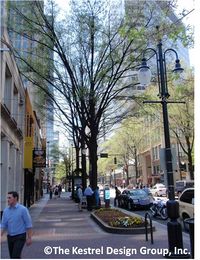
Carbon sequestration is the capture and long-term storage of carbon from atmospheric carbon dioxide. Sequestration occurs in plants and soil. Carbon sequestration is often discussed in the context of climate mitigation, but there are numerous benefits to increased carbon (organic matter) content in soils, including improved soil structure, infiltration through soil, nutrient retention and cycling, and pollutant attenuation.
The primary mechanism of carbon sequestration is through enhanced vegetative growth. Nowak and Crane (2002) estimated that, in 2002, urban trees stored 700 million tonnes of carbon with a gross carbon sequestration rate of 22.8 million tonnes of carbon per year. They estimated the average urban forest carbon storage density was 25.1 tonnes of carbon per hectare, compared with 53.5 tonnes of carbon per hectare in forest stands. This illustrates that urban forests store considerable carbon, but also that there may be opportunities for further increases in carbon storage.
Management activities can promote carbon sequestration in urban soils. Examples include leaving grass clippings and growing perennial gardens (see [9], [10]). Practices that promote deep rooting of vegetation establish stable carbon forms that extend deeply into the soil.
Jo (2001) presents the following strategies for green infrastructure practices that promote carbon sequestration in urban settings.
- Available growing space and planting potential could be increased by locating parking lots and above-ground utility lines below ground.
- Multi-layered plantings, in which herb, shrub, and tree layers overlap, would increase C storage and uptake per unit area, andmaintain amulti-aged tree structure to promote continuous C uptake over time.
- Ordinances should be amended to increase greenspace area in urban lands.
- Tree species that have high growth rates, even under adverse urban growing conditions, should be planted. Broad-leaved tree species have higher growth rates than conifers and shrubs.
- Natural lands, in which C storage and uptake per unit area are significant, should be conserved.
Brown et al. (2011) present strategies for minimizing the carbon footprint of urban areas. An important stratgey is better utilizing organic wastes generated within the urban landscape, including land application of organic waste.
Numerous stormwater activities can promote carbon sequestration. These include use of bioretention, tree trench/tree box, green roofs, and constructed wetland practices to treat stormwater runoff, improving soils and turf, and disconnecting impervious surfaces. Note that some stormwater practices, such as bioretention and green roofs, may export carbon, particularly in the first years after establishment. In addition, construction and maintenance of stormwater control practices leads to carbon emissions that can offset carbon sequestration. Moore and Hunt (2013) state "Despite accounting for sequestration by vegetation in these systems, only stormwater wetlands and grassed swales were predicted to store more carbon than what was released through construction and maintenance".
Additional information on stormwater management and carbon sequestration can be found in the following articles and reports.
- Carbon Sequestration Potential of Extensive Green Roofs
- Ecosystem service provision by stormwater wetlands and ponds – A means for evaluation?
- Assessing Soil Carbon Sequestration in Turfgrass Systems Using Long-Term Soil Testing Data
- The capacity of roadside vegetated filter strips and swales to sequester carbon
Enhanced biodiversity
The National Wildlife Federation defines biodiversity as the variety of life. Biodiversity can be considered at many levels, ranging from individual species to communities, landscapes, and ecosystems.
Biodiversity is important to ecosystem health, which in turn allows ecosystems to deliver services that humans require. Some of the benefits of enhanced biodiversity include the following.
- Provides for an array of foods and materials
- Provides medicines
- Enhances the delivery of ecosystem services, such as purifying air and water
- Provides resilience to ecosystems, which allows them to withstand disturbances (e.g. fires, diseases)
- Provides aesthetic and recreational value for humans
Biodiversity almost always decreases in human-impacted ecosystems, including urban landscapes. The primary reason for this is loss, fragmentation, or degradation of habitat. The loss of native vegetation and wildlife often promotes the spread of invasive species, which may further degrade or eliminate habitat. Aronson et al. (2014) studied bird and plant diversity in cities around the earth and observed the density of bird and plant species (the number of species per square kilometer) declined substantially: only 8% of native bird and 25% of native plant species were currently present compared with estimates of non-urban density of species. Additional information on impacts of urban landscapes on biodiversity can be found in these articles and reports.
- How does urbanization affect biodiversity? - provides a general discussion on the topic
- Urbanization, Habitat loss and Biodiversity Decline
- Urbanization, Biodiversity, and Conservation: The impacts of urbanization on native species are poorly studied, but educating a highly urbanized human population about these impacts can greatly improve species conservation in all ecosystems
- Urbanization as a Threat to Biodiversity: Trophic Theory, Economic Geography, and Implications for Conservation Land Acquisition
- A global analysis of the impacts of urbanization on bird and plant diversity reveals key anthropogenic drivers
Several strategies can minimize urban impacts on biodiversity loss, including the following.
- Managing residential vegetation in ways that promote native plants and animals. This includes, for example, growing perennials, establishing community gardens, selecting species that enhance biodiversity, and incorporating a variety of native vegetation into traditional turfed landscapes (e.g. golf courses, commercial turfed areas)
- Preserve existing green spaces
- Encourage the development of green corridors and increase connectivity of exiting green spaces
- Develop an ecologically informed public
- Controlling the establishment and spread of invasive species
Additional information on enhancing urban biodiversity can be found in the following articles and reports.
- Enhancing urban biodiversity and its influence on city-dwellers: An experiment
- 5 Best Ways to Increase Biodiversity in Urban Landscapes
- Biodiversity concepts and urban ecosystems
- Scaling up from gardens: biodiversity conservation in urban environments
- Urban Nature: How to Foster Biodiversity in World’s Cities
- Conserving urban biodiversity? Creating green infrastructure is only the first step
Stormwater practices can be designed to enhance bioversity while providing their basic function of treating stormwater. Examples of BMPs that directly impact biodiversity include bioretention, tree trenches and tree boxes, stormwater wetlands, green roofs, and disconnected impervious surfaces routed to pervious areas. Other BMPs can be designed to incorporate vegetative features that enhance biodiversity. For more information on the relationship between stormwater and green infrastructure, see Stormwater management, Green Infrastructure, and Low Impact Development.
Climate change resiliency, adaptation, and mitigation
Wikipedia defines climate resilience as the capacity for a socio-ecological system to: (1) absorb stresses and maintain function in the face of external stresses imposed upon it by climate change and (2) adapt, reorganize, and evolve into more desirable configurations that improve the sustainability of the system, leaving it better prepared for future climate change impacts. The difference between resilience and adaptation is subtle, but adaptation is often considered to be a response activity, often to a single issue, while resilience is a systems-based approach. Resilience and adaptation are responses to a changing climate, while mitigation involves attempts to reduce the magnitude or rate of climate change.
Effects of climate change on urban areas are well documented and beyond the scope of this article. For more information, see the following articles and reports.
- Climate Change and Urbanization Effects and Implications for Urban Governance
- Urban Areas and Climate Change: Review of Current Issues and Trends
- The Effects of Climate Change on the Vegetation of Central European Cities
- Mitigating and adapting to climate change: Multi-functional and multi-scale assessment of green urban infrastructure
Briefly, climate change effects in urban areas include the following.
- Increased risk of flooding
- Increased severity of storms
- Sea level rise
- Constraints on water supplies and other natural resources
- Increased temperatures and incidence of heat waves
- Health risks associated with water contamination and vectors
Green infrastructure and climate change resiliency and adaptation
The U.S. Environmental Protection Agency developed an excellent website, titled Green Infrastructure for Climate Resiliency, that describes green infrastructure practices that can help communities prepare for and manage these effects of climate change. These practices includes the following.
- Managing flooding with infiltration-based practices. Infiltration practices include bioinfiltration (rain gardens); tree trenches and tree boxes; infiltration trenches, basins, and underground infiltration; permeable pavement; and swales designed with check dams or bioretention bases. Rainwater/stormwater harvest systems used for irrigation, improved soil, and disconnecting impervious surfaces and routing runoff to pervious surfaces also utilize infiltration.
- Managing flooding with open space preservation. Natural area conservation protects natural resources and environmental features that help maintain the pre-development hydrology of a site by reducing runoff, promoting infiltration and preventing soil erosion.
- Building resiliency to drought. Rainwater and stormwater can be [captured (harvested) and used for irrigation or as a gray water source. Properly treated harvested water can also be used as a source of potable water in some locations. Stormwater infiltration also keeps rainwater nears its source, which can improve local hydrology and replensih groundwater supplies, thus buffering periods of drought.
- Reducing urban heat island effects. Trees, green roofs, and replacing impermeable surfaces with vegetation can help reduce urban heat island effects by shading building surfaces, deflecting radiation from the sun, and releasing moisture into the atmosphere.
- Lowering energy demands for buildings and managing water. Trees and vegetative cover can lower ambient air temperatures in urban areas through shading, windbreak, and evapotranspiration. Green roofs can significantly reduce building energy costs by insulating throughout the year. Harvesting and using rainwater or stormwater can reduce water demands and energy needed to meet water demands.
Green infrastructure and climate change mitigation
The role of green infrastructure in climate change mitigation in urban areas primarily consists of increasing storage of carbon. This is discussed in greater detail in the section on carbon sequestration.
Water quantity and quality
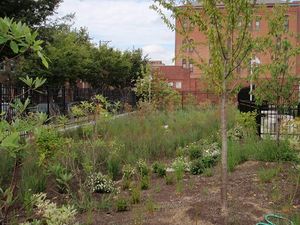
One of the principal goals of green infrastructure is to mimic natural processes. This includes retaining rainwater as close to its source as possible and allowing it to infiltrate or using the water (e.g. as a gray water source). Retaining rainwater has several benefits summarized below and discussed in greater detail in an EPA report titled Benefits of Green Infrastructure.
- Water collected in rainwater harvesting systems can be used for outdoor irrigation and some indoor uses and can significantly reduce municipal water use
- Water infiltrated into the soil can recharge ground water and improve baseflow to local streams. It should be noted there are few studies attempting to quantify the effect of rainwater infiltration on groundwater recharge and stream baseflow.
- Green infrastructure can mitigate flood risk by slowing and reducing stormwater discharges.
- By retaining rainfall from small storms, green infrastructure reduces stormwater discharges. Lower discharge volumes translate into reduced combined sewer overflows and lower pollutant loads. Green infrastructure also treats stormwater that is not retained.
- Retaining rainwater provides additional benefits related to climate change, and enhancing biodiversity.
Infiltration practices include bioinfiltration (rain gardens); tree trenches and tree boxes; infiltration trenches, basins, and underground infiltration; permeable pavement; and swales designed with check dams or bioretention bases. Rainwater/stormwater harvest systems used for irrigation, improved soil, and disconnecting impervious surfaces and routing runoff to pervious surfaces also utilize infiltration.
Stormwater practices that infiltrate runoff reduce pollutant loading to surface receiving water (lakes, streams, wetlands). Infiltration practices are among the most effective methods for maintaining or improving surface water quality. An EPA report titled Performance of Green Infrastructure provides a literature summary of green infrastructure effects on water quality.
Most infiltration practices provide significant pollutant removal as captured runoff infiltrates vertically. Exceptions include chloride, which is not attenuated; nitrate, unless denitrifying conditions occur within the vertical soil profile; and some organic pollutants. Soils with very high infiltration rates and low organic matter content may also be less effective at removing pollutants.
Green infrastructure practices that do not infiltrate stormwater or provide limited infiltration typically provide treatment of runoff. Most pollutants are effectively removed. However, chloride and nitrate are not effectively treated and phosphorus may be exported from some practices that utilize engineered media with a high organic matter content. Examples of BMPs that may export phosphorus include green roofs, swales, and bioretention practices.
Additional information can be found in this manual on the following pages.
- Surface water and groundwater quality impacts from stormwater infiltration
- Pollutant fate and transport in stormwater infiltration systems
Air quality
Green infrastructure practices help mitigate air pollution in urban areas. The primary mechanism is sequestration of pollutants by vegetation. Trees, in particular, are effective at sequestering pollutants. Vegetation may also reduce energy demand by providing shade and adsorbing solar energy, which in turn results in reduced emission of pollutants. The cumulative air quality improvement obtained from green infrastructure therefore includes direct and indirect benefits in resource units or monetary value. Stormwater practices that promote vegetation include bioretention, tree trench/tree box, green roofs, vegetated swales, and improved turf.
Some articles providing information on pollutant and energy reductions associated with green infrastructure include the following, with primary conclusions from the studies shown in quotations..
- Akbari, H., M. Pomerantz, H. Taha. 2001. Cool surfaces and shade trees to reduce energy use and improve air quality in urban areas. Sol. Energy, 70 (2001), pp. 295-310. "Mitigation of urban heat islands can potentially reduce national energy use in air conditioning by 20% and save over $10B per year in energy use and improvement in urban air quality."
- Baró, F. L. Chaparro, E. Gómez-Baggethun, J. Langemeyer, D.J. Nowak, J. Terradas. 2014. Contribution of ecosystem services to air quality and climate change mitigation policies: the case of urban forests in Barcelona, Spain. Ambio, 43 (4) (2014), pp. 466-479. "Our results show that the contribution of urban forests regulating services to abate pollution is substantial in absolute terms, yet modest when compared to overall city levels of air pollution and GHG emissions. We conclude that in order to be effective, green infrastructure-based efforts to offset urban pollution at the municipal level have to be coordinated with territorial policies at broader spatial scales."
- Currie, B.A., B. Bass. 2008. Estimates of air pollution mitigation with green plants and green roofs using the UFORE model. Urban Ecosystems. December 2008, Volume 11, Issue 4, pp 409–422. "Results of the study indicate that grass on roofs (extensive green roofs) could augment the effect of trees and shrubs in air pollution mitigation, placing shrubs on a roof (intensive green roofs) would have a more significant impact."
- Jayasooriya, V.M. A.W.M Ng, S. Muthukumaran, B.J.C. Perera. 2017. Green infrastructure practices for improvement of urban air quality. Urban Forestry & Urban Greening. Volume 21, January 2017, Pages 34-47 "The results showed that, trees provided the highest air pollution removal capability among the different GI considered for the study area. Combination of different GI such as green roofs and green walls with trees did not provide a significant increment of air quality improvement however, has provided more local benefits such as building energy savings."
- McPherson, E. Gregory; Nowak, David J.; Rowntree, Rowan A. eds. 1994. Chicago's urban forest ecosystem: results of the Chicago Urban Forest Climate Project. Gen. Tech. Rep. NE-186. Radnor, PA: U.S. Department of Agriculture, Forest Service, Northeastern Forest Experiment Station: 201 p. "Results of the 3-year Chicago Urban Forest Climate Project indicate that there are an estimated 50.8 million trees in the Chicago area of Cook and DuPage Counties; 66 percent of these trees rated in good or excellent condition. During 1991, trees in the Chicago area removed an estimated 6,145 tons of air pollutants, providing air cleansing valued at $9.2 million dollars, These trees also sequester approximately 155,000 tons of carbon per year, and provide residential heating and cooling energy savings that, in turn, reduce carbon emissions from power plants by about 12,600 tons annually."
- Nowak, D.J. D.J. Nowak, D.E. Crane, J.C. Stevens. 2006. Air pollution removal by urban trees and shrubs in the United States. Urban For. Urban Green., 4 (2006), pp. 115-123 "Pollution removal (O3, PM10, NO2, SO2, CO) varied among cities with total annual air pollution removal by US urban trees estimated at 711,000 metric tons ($3.8 billion value)."
Other benefits of green infrastructure
There are additional benefits to green infrastructure beyond environmental benefits. These are described briefly below.
Sustainable communities
Sustainable communities are places that balance their economic assets, natural resources, and social priorities so that residents' diverse needs can be met now and in the future.
Communities want to protect their water quality while also getting the greatest possible benefit out of every investment they make. Many are conserving, restoring, or enhancing natural areas while incorporating green infrastructure practices, such as trees, rain gardens, green roofs and other practices. These green infrastructure practices mimic natural systems into developed areas to manage rainwater where it falls. Green infrastructure practices are an integral component of sustainable communities because they can help communities protect the environment and human health while providing other social and economic benefits, allowing communities to achieve more for their money. Using green infrastructure practices strategies to reduce stormwater runoff can strengthen efforts to preserve open space and natural areas and encourage development in existing communities. These practices help make neighborhood streets and greenways pleasant and safe for walking and biking and reinforce a sense of place. Integrating green infrastructure and sustainable communities encourages collaboration in development decision and promotes green building practices.
Sustainable communities that fully integrate green infrastructure approaches use community design to help simultaneously achieve environmental, economic, and social goals. These goals include improving water quality, revitalizing neighborhoods, reducing flood risk, and providing recreational areas that encourage physical activity. Community planners can enhance these and other benefits by selecting the types and locations of green infrastructure practices that best support their goals.
To learn more about sustainable communities and green infrastructure, including how to develop a Sustainable Communities and Green Infrastructure Plan, read the EPA's report on Enhancing Sustainable Communities with Green Infrastructure.
Living (green) streets
A living street is new type of street that is narrower and has less pavement than existing streets. Reducing the width of existing streets reduces construction costs and allows room for the installation of trees and rainwater gardens to treat stormwater. Where there is a need, bike trails and sidewalks are installed to provide for safe pedestrian and bike movement. Living streets are designed for cars, people and the environment. Rainwater gardens and street trees remove pollutants from stormwater before the water enters area lakes, helping to improve lake quality. Narrower streets and street trees also slow traffic, creating a safe environment for everyone. In 2012, the City of Maplewood partnered with the Ramsey Washington Metro Watershed District to install a living streets demonstration project. For more detailed information about the project, go to the Ramsey Washington Metro Watershed District web site.
A green street is a stormwater management approach that incorporates vegetation, soil and engineered systems such as pavement to slow, filter and cleanse stormwater runoff from impervious surfaces such as streets and sidewalks. Green streets are designed to capture rainwater at its source, where rain falls.
Green streets protect water quality in rivers and streams by removing up to 90 percent of pollutants. They replenish groundwater supplies, absorb carbon, improve air quality and neighborhood aethestics, and provide green connections between parks and open space. Vegetated curb extensions improve pedestrian and bicycle safety and calm traffic. For information on green streets can be found on the EPA's web site
One principle of green infrastructure involves reducing and treating stormwater close to its source. Green streets provide a source control for a main contributor of stormwater runoff and pollutant load. In addition, green infrastructure practices complement street facility upgrades, street aesthetic improvements, and urban tree canopy efforts that also make use of the right-of-way and allow it to achieve multiple goals and benefits.
Green streets can incorporate a wide variety of design elements including street trees, permeable pavements, bioretention and swales. Successful application of green techniques will encourage soil and vegetation contact and infiltration and retention of stormwater. Bioretention is a versatile green street strategy. Bioretention practices can be tree boxes taking runoff from the street, as well as planter boxes or curb extensions. Permeable Pavement systems have an aggregate base which provides structural support, runoff storage and pollutant removal through filtering and adsorption. Tree trenches and tree boxes reduce stormwater runoff, help to reduce the urban heat island effect, improves air quality and urban aesthetics.
Watch a video, produced by the EPA on the benefits of Green Streets
Human health
Healthy ecosystems provide important health benefits to humans, as discussed above (e.g. clean air and water, pollination, etc.). Several studies indicate additional health benefits to humanns, including increased physical activity, reduced stress, increased social capital, reduced incidence of disease, and climate regulation. The following articles and reports provide information on human health effects of green infrastructure.
- Green Infrastructure, Ecosystem Services, and Human Health, (2015) - provides a comprehensive literature review of human health effects associated with green infrastructure and ecosystem services.
- Health and Green Infrastructure (2015) - a U.S. E.P.A. fact sheet summarizing economic, environmental, and equity impacts from implementation of green infrastructure.
- Green Infrastructure and Public Health. Christopher Coutts. 2016. Routledge, London and New York.
- Water and Wellness: Green Infrastructure for Health Co-Benefits (2014) - a short srticle summarizing health effects of green infrastructure
- Promoting ecosystem and human health in urban areas using Green Infrastructure: A literature review (2007) - provides a literature review, primarily of technical papers, on the relationship between green space, ecosystems, and human health.
Recommended reading
- Critical Review of Technical Questions Facing Low Impact Development and Green Infrastructure: A Perspective from the Great Plains. Jason R. Vogel, Trisha L. Moore, Reid R. Coffman, Steven N. Rodie, Stacy L. Hutchinson, Kelsey R. McDonough, Alex J. McLemore, and John T. McMaine.
- The Value of Green Infrastructure for Urban Climate Adaptation. 2011. Josh Foster, Ashley Lowe, Steve Winkelman.
References
- Aronson, M.F.J., F. A. La Sorte, C. H. Nilon, M. Katti, M. A. Goddard, C. A. Lepczyk, P. S. Warren, N. S. G. Williams, S. Cilliers, B. Clarkson, C. Dobbs, R. Dolan, M. Hedblom, S. Klotz, J. L. Kooijmans, I. Kühn, I. MacGregor-Fors, M. McDonnell, U. Mörtberg, P. Pyšek, S. Siebert, J. Sushinsky, P. Werner, and M. Winter, 2014. A global analysis of the impacts of urbanization on bird and plant diversity reveals key anthropogenic drivers. Proceedings of the Royal Society B. Volume 281, Issue 1780.
- Brown, S., E. Miltner, C. Cogger. 2011. Carbon Sequestration Potential in Urban Soils. In Carbon Sequestration in Urban Ecosystems. Editors: Rattan Lal, Bruce Augustin. Springer Nature.
- Costanza, Robert, Rudolf de Groot, Paul Sutton, Sander van der Ploeg, Sharolyn J. Anderson, Ida Kubiszewski, Stephen Farber, and R. Kerry Turner. 2014. Changes in the global value of ecosystem services. Global Environmental Change. 26:152-158.
- Jo, Hyun-Kil. 2001. Impacts of urban greenspace on offsetting carbon emissions for middle Korea. Journal of Environmental Management (2002) 64, 115–126.
- Moore, T.L.C., W.F. Hunt. 2013. Predicting the carbon footprint of urban stormwater infrastructure. Ecological Engineering Volume 58, September 2013, Pages 44-51.
- Nowak, D.J. and D.E. Crane. 2002. Carbon storage and sequestration by urban trees in the USA. Environmental Pollution. 116:3:381-389.
This page was last edited on 10 February 2023, at 13:29.
